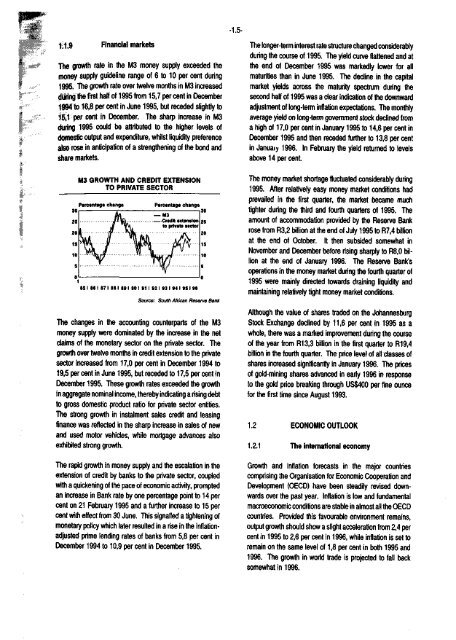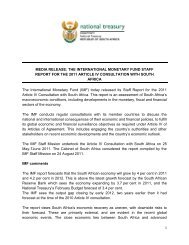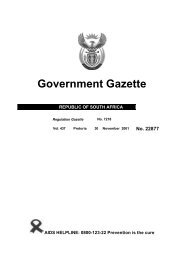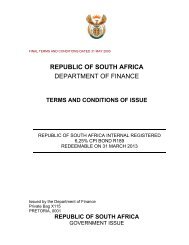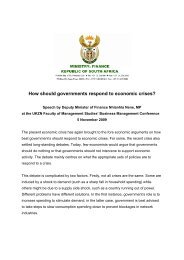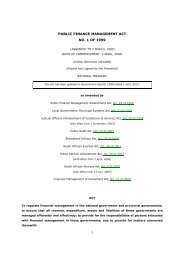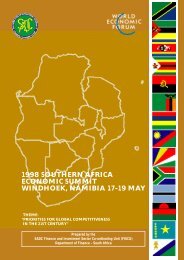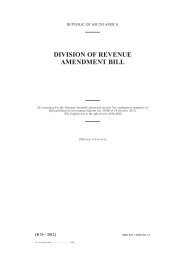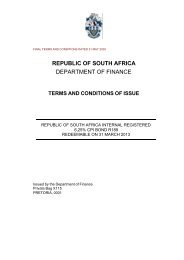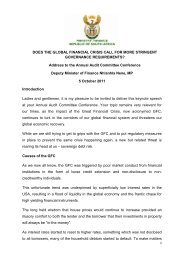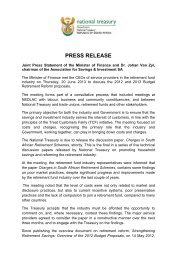1996 - National Treasury
1996 - National Treasury
1996 - National Treasury
You also want an ePaper? Increase the reach of your titles
YUMPU automatically turns print PDFs into web optimized ePapers that Google loves.
-1.5-<br />
1.1.9 Financial markets<br />
The growth rate in the M3 money supply exceeded the<br />
money supply guideline range of 6 to 10 per cent during<br />
1995. The growth rate over twelve months in M3 increased<br />
during the first half of 1995 from 15,7 per cent in December<br />
1994 to 16,8 per cent in June 1995, but receded slightly to<br />
15,1 per cent in December. The sharp increase in M3<br />
during 1995 could be attributed to the higher levels of<br />
domestic output and expenditure, whilst liquidity preference<br />
also rose in anticipation of a strengthening of the bond and<br />
share markets.<br />
M3 GROWTH AND CREDIT EXTENSION<br />
TO PRIVATE SECTOR<br />
Percentage change<br />
Percentage change<br />
15 I 86 I »7 I 88 I 89 I 90 I 91 I 92 I 93 I 94 I 951 98<br />
Source: South African Reserve Bank<br />
The changes in the accounting counterparts of the M3<br />
money supply were dominated by the increase in the net<br />
claims of the monetary sector on the private sector. The<br />
growth over twelve months in credit extension to the private<br />
sector increased from 17,0 per cent in December 1994 to<br />
19,5 per cent in June 1995, but receded to 17,5 per cent in<br />
December 1995. These growth rates exceeded the growth<br />
in aggregate nominal income, thereby indicating a rising debt<br />
to gross domestic product ratio for private sector entities.<br />
The strong growth in instalment sales credit and leasing<br />
finance was reflected in the sharp increase in sales of new<br />
and used motor vehicles, while mortgage advances also<br />
exhibited strong growth.<br />
The rapid growth in money supply and the escalation in the<br />
extension of credit by banks to the private sector, coupled<br />
with a quickening of the pace of economic activity, prompted<br />
an increase in Bank rate by one percentage point to 14 per<br />
cent on 21 February 1995 and a further increase to 15 per<br />
cent with effect from 30 June. This signalled a tightening of<br />
monetary policy which later resulted in a rise in the inflationadjusted<br />
prime lending rates of banks from 5,8 per cent in<br />
December 1994 to 10,9 per cent in December 1995.<br />
The longer-term interest rate structure changed considerably<br />
during the course of 1995. The yield curve flattened and at<br />
the end of December 1995 was markedly lower for all<br />
maturities than in June 1995. The decline in the capital<br />
market yields across the maturity spectrum during the<br />
second half of 1995 was a clear indication of the downward<br />
adjustment of long-term inflation expectations. The monthly<br />
average yield on long-term government stock declined from<br />
a high of 17,0 per cent in January 1995 to 14,6 per cent in<br />
December 1995 and then receded further to 13,8 per cent<br />
in January <strong>1996</strong>. In February the yield returned to levels<br />
above 14 per cent.<br />
The money market shortage fluctuated considerably during<br />
1995. After relatively easy money market conditions had<br />
prevailed in the first quarter, the market became much<br />
tighter during the third and fourth quarters of 1995. The<br />
amount of accommodation provided by the Reserve Bank<br />
rose from R3,2 billion at the end of July 1995 to R7,4 billion<br />
at the end of October. It then subsided somewhat in<br />
November and December before rising sharply to R8,0 billion<br />
at the end of January <strong>1996</strong>. The Reserve Bank's<br />
operations in the money market during the fourth quarter of<br />
1995 were mainly directed towards draining liquidity and<br />
maintaining relatively tight money market conditions.<br />
Although the value of shares traded on the Johannesburg<br />
Stock Exchange declined by 11,6 per cent in 1995 as a<br />
whole, there was a marked improvement during the course<br />
of the year from R13.3 billion in the first quarter to R19.4<br />
billion in the fourth quarter. The price level of all classes of<br />
shares increased significantly in January <strong>1996</strong>. The prices<br />
of gold-mining shares advanced in early <strong>1996</strong> in response<br />
to the gold price breaking through US$400 per fine ounce<br />
for the first time since August 1993.<br />
1.2 ECONOMIC OUTLOOK<br />
1.2.1 The international economy<br />
Growth and inflation forecasts in the major countries<br />
comprising the Organisation for Economic Cooperation and<br />
Development (OECD) have been steadily revised downwards<br />
over the past year. Inflation is low and fundamental<br />
macroeconomic conditions are stable in almost all the OECD<br />
countries. Provided this favourable environment remains,<br />
output growth should show a slight acceleration from 2,4 per<br />
cent in 1995 to 2,6 per cent in <strong>1996</strong>, while inflation is set to<br />
remain on the same level of 1,8 per cent in both 1995 and<br />
<strong>1996</strong>. The growth in world trade is projected to fall back<br />
somewhat in <strong>1996</strong>.


